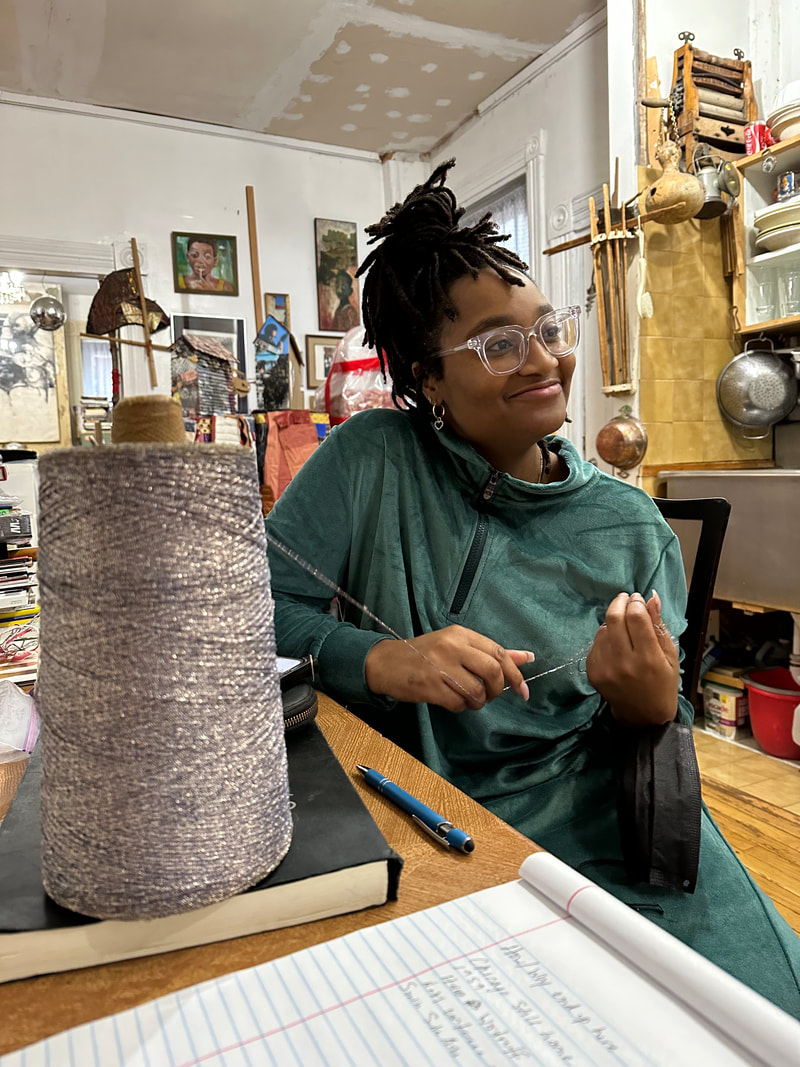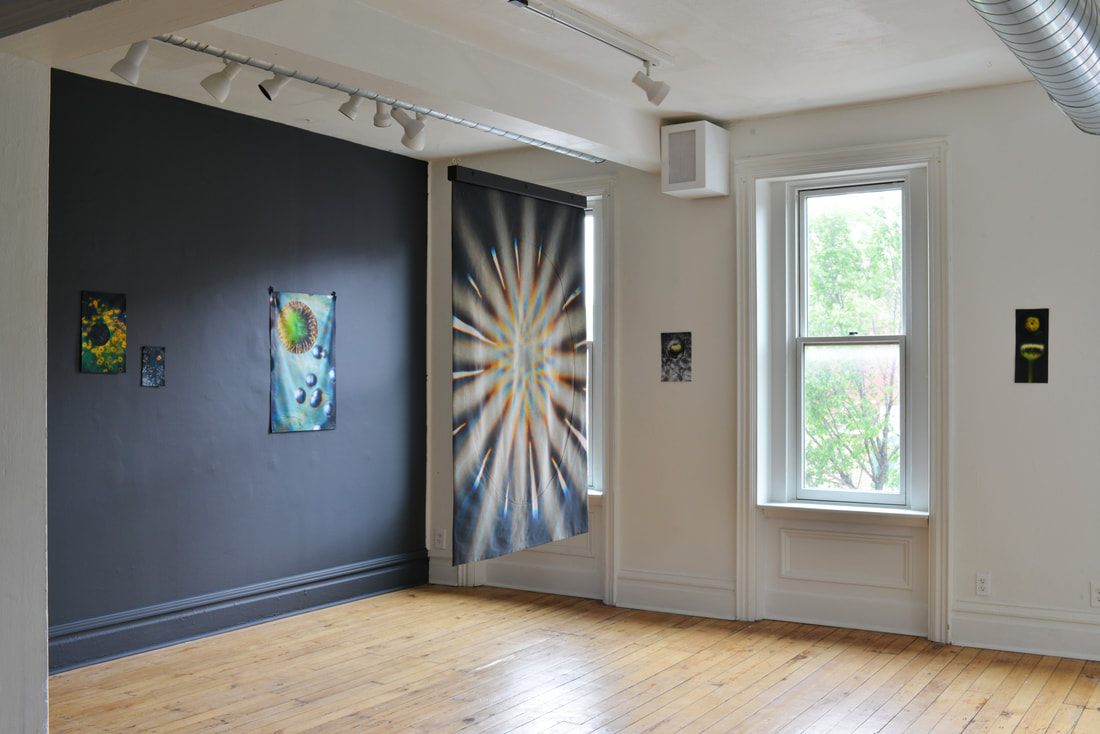Review by Kelly Sheridan
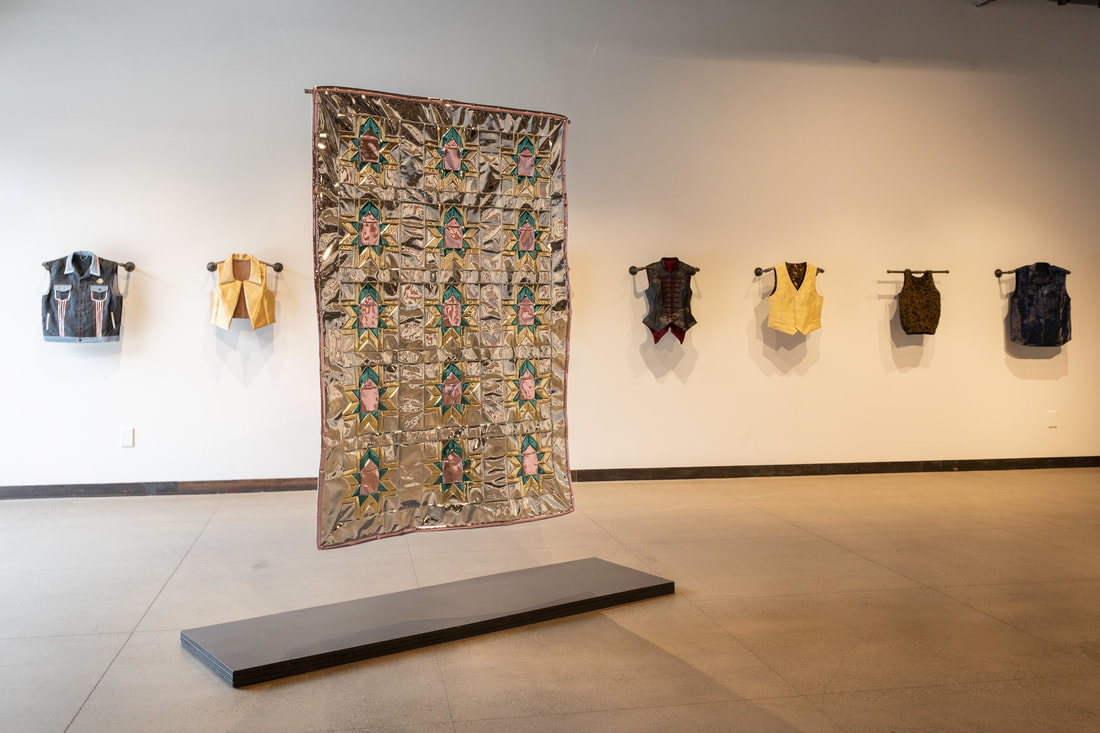
Installation view of Self (2023)
9/26/23
The views and opinions expressed in this article are solely those of the author. They do not reflect the opinions or views of Bunker Projects or its members. All images courtesy of Contemporary Craft unless otherwise indicated.
Self was a two person exhibition at Contemporary Craft that invited the community to question binary constructs of identity, gender, and heteronormative expectations. Erika Diamond and matt lambert both use craft to challenge rigid systems of thinking that often are reinforced by policies and social institutions, like the strict presumptions that there are only two genders and one ‘natural’ sexual orientation. In addition to presenting a space to assess dominant ideologies, the show is a reminder that crafting requires us to listen to our bodies.
For those who may not have a clear idea of what constitutes craft (like me), I find it a struggle to provide a simple definition, because craft has been politicized, industrialized, and analyzed (as art and as not-art) in numerous contexts throughout history. Choosing one definition of craft seems too restrictive to describe what I’m observing it to be in this exhibition: an all-embracing and ever-expanding art form.
Walking into the gallery, the white noise of conventionality dissipates as I become surrounded with a multimedia assemblage of photo, sculpture, and found objects from matt lambert. Through metalsmithing, antique restoration, leatherworking, and photography, matt explores identity and the body through the reinterpretation of various materials like those traditionally embraced in ‘hetero-masculine’ settings such as the military, hunting, or athletics. I eventually reach the back of the gallery where Erika Diamond’s series of bullet-proof safety vests and mirrored vinyl textiles hang, directing me to confront the contemporary restrictions on self-expression and the fears and limitations they instill in us. As I articulate my experience of the show, I consider the distinct ways in which Erika and matt resist capitalist consumptive models of both craft and self-worth, observing where the artists’ works contradict each other and how they fall into communion.
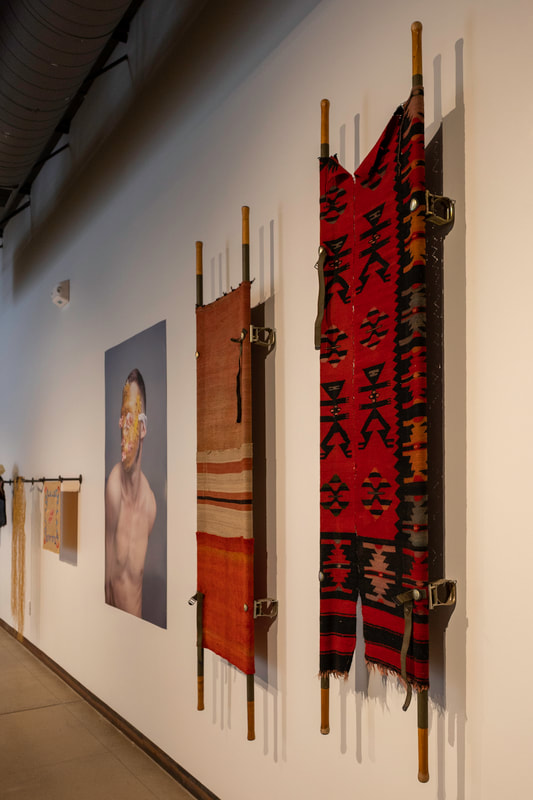
Installation view of Self (2023)
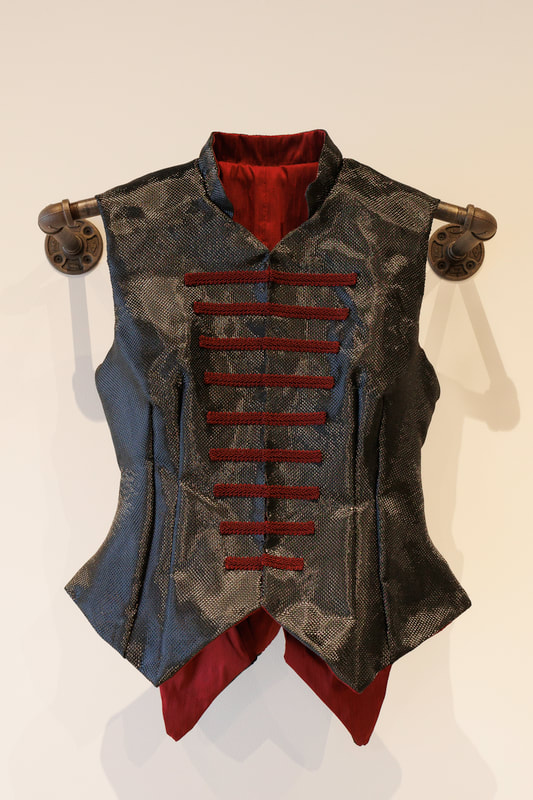
Erika Diamond, Francis Vest I (2023)
Capitalism of Craft, and Capitalism of Self
In Contemporary Craft’s podcast, Sounds from the Studio, matt lambert sweetly alludes to how a flower isn’t only valuable when it blooms, prompting us to more deeply consider how the larger industry of craft and fine arts might reinforce the belief that when something becomes art is when it becomes valuable. To approach craft as a means of fostering individual wellbeing and community connectedness, without an agenda to cater to the standards of a larger industry, is a practice associated with many indigenous experiences. A publication by Art/Research International describes this contemporary reimagining of indigenous notions of craft as a response to increasing globalization: “Traditional and Indigenous craft-making practices are being reimagined as important ways of remembering and reclaiming – of disrupting dominant discourse and making sense of our worlds.”
I had assumed craft in a post-industrial, post-colonial society was reduced to the learned skills and techniques for creating aesthetic objects that have domestic function (an artist’s ‘value’ in terms of productivity and capability). In fact, Erika and matt, among many other contemporary artists, use craft to examine the societal issues that result from such conditions. Politically engaged craft-making methods like this are referred to as “craftism”, a term popularized by activist Betsy Greer in 2003. But this concept is seen in practices that even go back to Homer’s ancient epic The Odyssey, which references women weaving messages into fabric when they were silenced or oppressed, using these skills to protest gender-based violence. With craft being used as an act of defiance since early civilization, I don’t see it ever losing relevance in society…as the evolution of craft and humanity seem to be elementally intertwined.
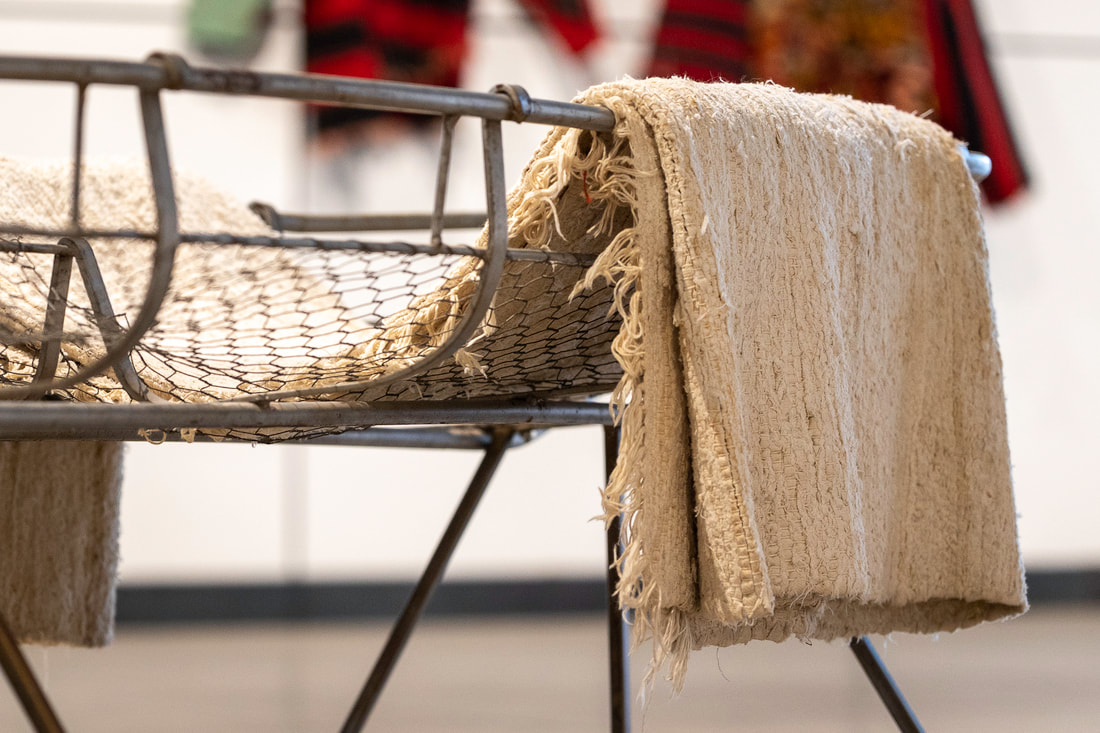
Installation view of Self (2023)
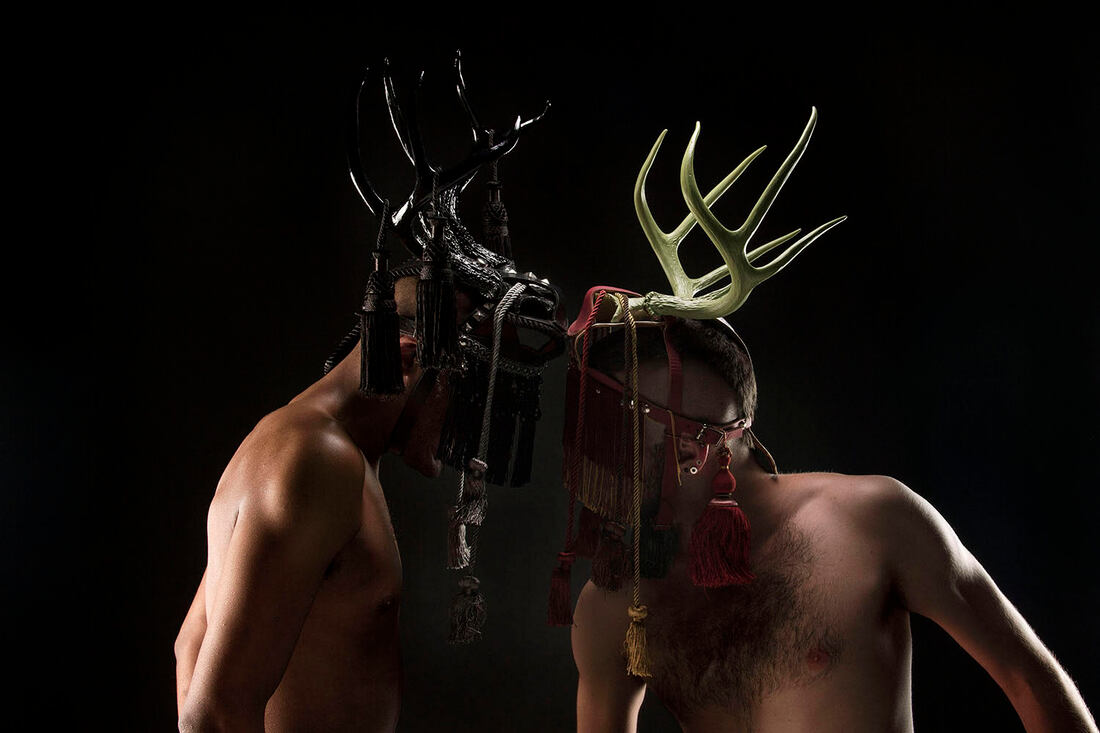
matt lambert, “The Joust” (2023), photo by Danya Ensing, courtesy of matt lambert
Disorder > ‘Pearls of Wisdom’
matt lambert’s work includes worn steel trophy rings sitting neatly inside a jewelry case next to protective headgear made of leather, tassels, and a foraged fencing helmet. Necklaces made of wood, steel, a vintage sports mask, and other materials are hanging on a wall, overlapping a large photograph of two half-naked bodies posing in crafted headgear like bucks locking antlers and pushing each other to establish dominance (perhaps queering dominant modes of performative masculinity). Antique tribal print rugs wrap around used military stretchers, large tassels enigmatically dangle from the ceiling beams, and large steel baskets are positioned across the floor.
These exhibited works exclude labels or written language to accompany them, a calm refusal to conform to the dominant standards in the field and instead a reclamation of craft making practices prior to globalization. This decision is significant because it invites us to identify with the exhibition ourselves rather than being immediately offered ‘pearls of wisdom’. Although I usually enjoy reading the little white label that accompanies a piece to advance or broaden my perception, excluding the written word encourages viewers to find alternative ways to perceive the work in light of their own experiences and observations. Instead of reading the discourse behind something, there’s something more communal about stories being told and exchanged without any words; without any constraints.
While observing this nomadic, temporary attitude toward positioning the work, I ask a gallery associate about the curatorial process. They describe matt arriving at Contemporary Craft from Sweden, where they work on their PhD at Konstack University of Arts, Crafts, and Design, with suitcases of objects and wearable works to include (or not include) in the show. The act of waiting until arrival to determine how their work will inhabit the space is part of the creative experience, reflecting matt’s polydisciplinamory practice as a performance artist (among many other things).
As a metalsmith, the ways in which matt forges and reconfigures metal is beautifully symbolic. In an interview for Lost in Jewelry Magazine, they describe metal as, “… such a fluid thing…We can melt it down…We can evolve it; we can rework it. There’s an interesting poetry in that… I really enjoy the metaphor that’s involved in the material of metal that we can, as makers, choose to alter it completely, reconfigure it, or break it down and rebuild it. And that is a reflection of our identities as we evolve as people.”
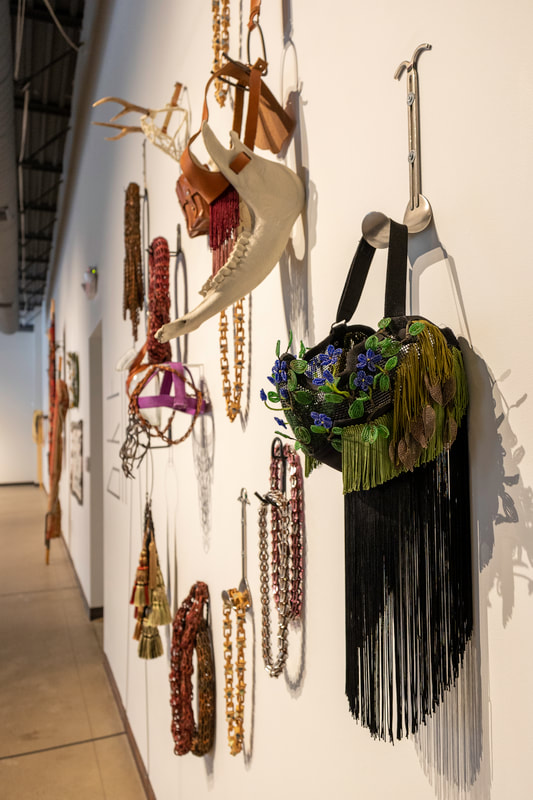
Installation view of Self (2023)
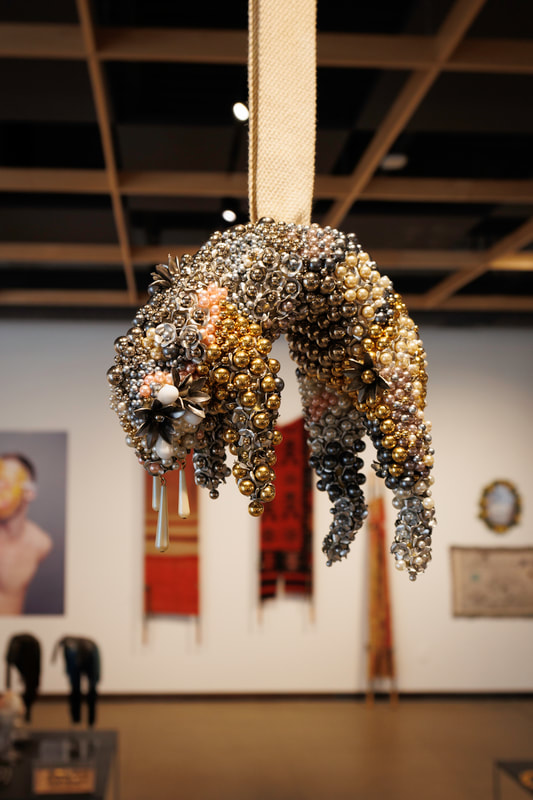
Installation view of Self (2023)
As a photographer, they incorporate some of the objects on display in a series of portraits. The photoshoot behind the works included in Self was described as an act of play where the models express their intersectional queer identities. Historical portraiture is loosely referenced in their poses, portraying how queer bodies existed (and still exist) in colonial dominated spaces. This approach acknowledges how those spaces have been defined and when it is a creative opportunity to unpin those definitions.
In the past several decades, many artists have used photo-based work to address these colonial histories. As the invention of photography occurred shortly before Europe’s colonial powers began to colonize Africa in the 1880s, the camera became a tool to control representations of power and personhood. Artist Sonia Boyce used photography to demonstrate the effect of African peoples’ historical dispersion through enslavement and colonization, and its impact on the identities and representations of Black people over the following century.
You may have noticed by now that matt’s name isn’t capitalized. This is because they believe in focusing on the importance of the work and not the artist’s name. I also see this as a dedication to separate craft from the capitalist, or elitist, systems it has become susceptible to. Their work seems to recodify those very structures by redeploying objects that may have been claimed by a specific social construct or historical narrative, and giving them the freedom to be used (and redefined) in an infinite amount of ways.
Measurements of Safety & Haute Couture
Erika Diamond’s work includes a collection of fashionable bullet-proof vests, pictured below, designed to demonstrate the perils LGBTQIA+ individuals face and the need to feel safe in a society that provides inadequate protection at best, deliberate inequitable safety at worst. The short descriptions that accompany each vest (found in the gallery guide) describe the specific individual she designed them for, and the way that piece uniquely protects and validates their personal fears and vulnerabilities in public spaces.
Broadly speaking, fashion statements can sometimes become susceptible to political cliches (think Alexandria Ocasio-Cortez wearing the white dress by Aurora James with “Tax the Rich” painted across it or Cara Delevingne wearing the “Peg the Patriarchy” bullet-proof vest designed by Dior’s Maria Grazia Chiuri at the Met Gala). I can appreciate the designers’ attempt to give craftivism mainstream exposure, but I think it is who these pieces were designed for that had us all cringing at the performative, “cosplay” radicalism.
If anything, those are just prime examples of how custom fashion is a privilege for some and a danger for others. Erika’s designs were intentionally made with the level of detail that would be considered couture, but she uses bullet-proof Kevlar material to re-define high fashion for those who actually require protection wherever they want to simply dress up for a night out.
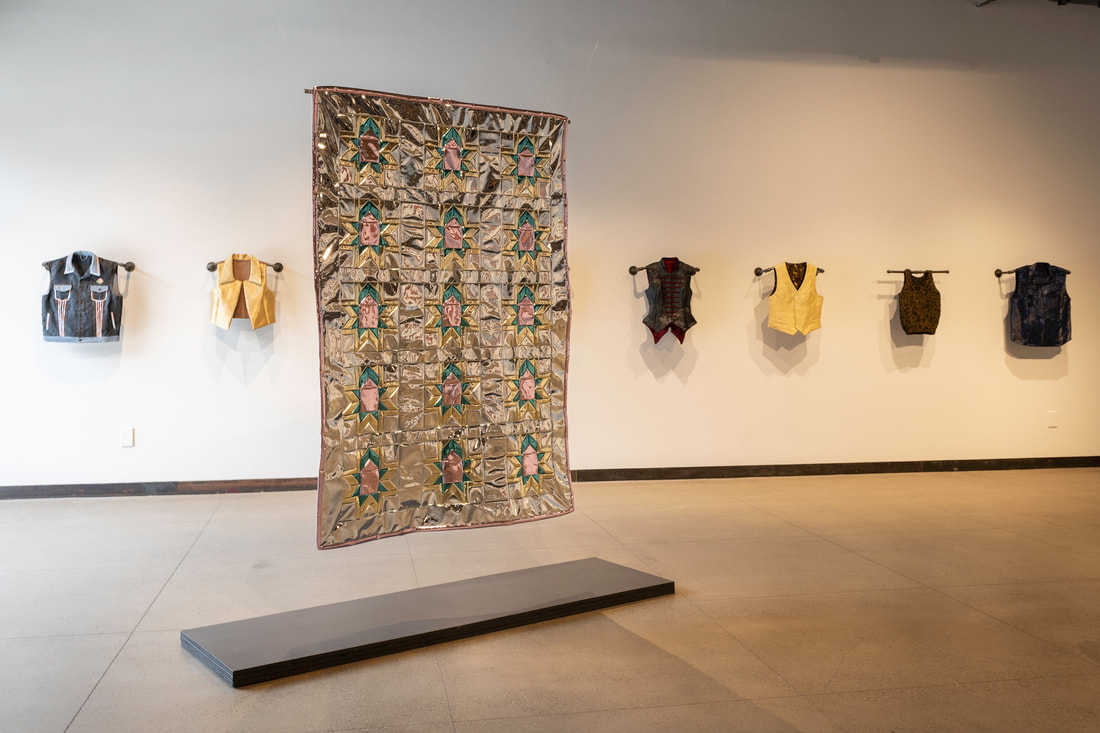
Installation view of Self (2023)
Erika designed a quilt pattern with little pink houses to bring awareness to the fact that 40% of youth experiencing housing insecurity in the US are LGBTQIA+. The quilt is a spin on the Virginia State quilt block, which represents the popular tradition of early colonial quiltmaking among upper class women in the mid-1700s. Similar to matt’s instinct to give certain objects new meaning by redeploying their colonial histories, Erika rethinks the traditional application of quilt blocks that often glorified problematic periods in American history and uses it as a means of paying tribute to the queer community. The quilt’s lining is a rainbow pattern of pronouns “she – he – they” to highlight that the most-lifesaving factor in a gender-diverse child’s well-being is a parent’s use of their child’s pronouns. I’ve come to learn that not only is quilt activism still active, but it is one of the most meaningful ways an artist can use their skills to connect communities. The largest community art project in the world to exist so far is The NAMES Project’s AIDS Memorial Quilt that consists of 48,000 3’ x 6’ panels and 94,000 names of individuals who died from the disease. Displayed in Washington, D.C. in 1987, this was one of the most effective tools in raising awareness about the epidemic.
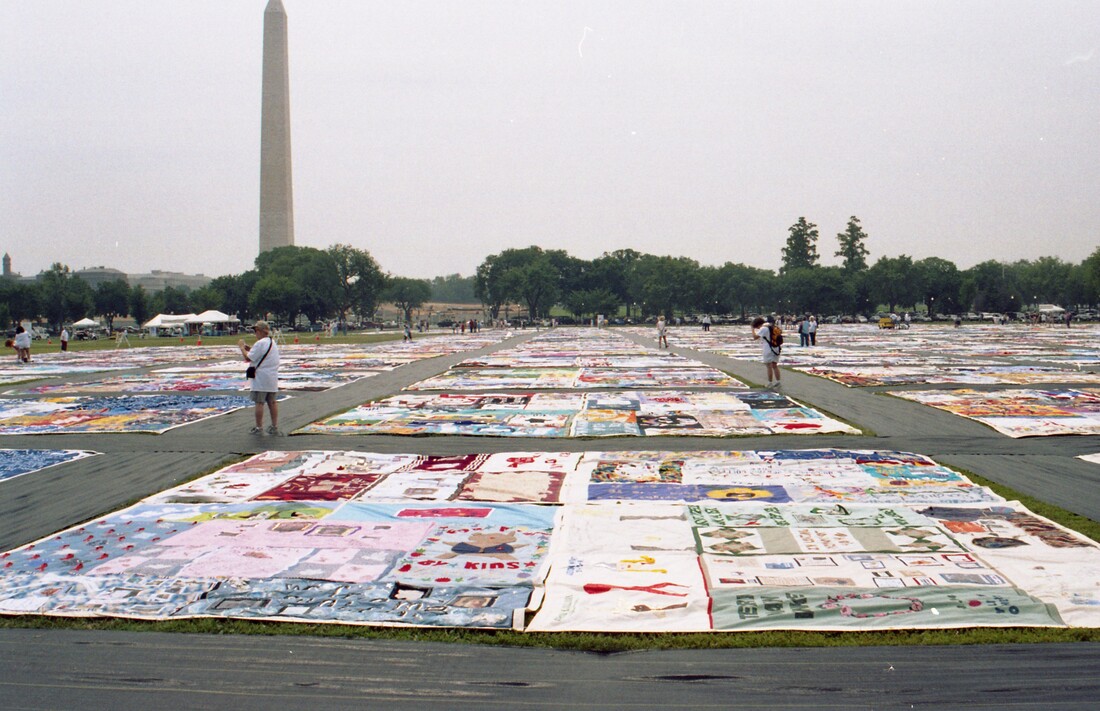
NAMES Project AIDS Memorial Quilt Opening Ceremony on the Ellipse at Presidents Park across from the White House in NW Washington DC on Friday morning, 25 June 2004. Photo by Elvert Barnes, courtesy of Flickr
I also want to mention an object/performance piece Erika embarked on in 2014 titled Crush ~ Keep as another example of craft (and quilting in particular) creating community. During a month-long residency within the gallery at Black Iris in Richmond, VA, she asked visitors to donate any type of fabric (tablecloths, fabric scraps, old clothes, etc.) to become part of an ever-growing garment that represents the space and those she interacted with in it. She describes the performance aspect of the piece as, “a metaphor for the beauty and burden of constructing and maintaining relationships, this garment was then worn during my Exit Performance on October 17, 2014, during which I cut and pulled the garment free from the gallery space. Spectators chose to follow me as I exited the space and walked 4 blocks to the Jefferson Hotel.”
Other pieces in Erika’s display bring you face to face with evidence of legislative and social efforts to erase queer existence and invalidate the need for safe spaces for students in U.S schools. Her backpack design, accompanied by a stack of banned LGBTQIA+ books, symbolizes queerness needing to be a “secret” in a school environment. She also includes a hoodie design that she titled (In)visible, representing the decision to be out but threatened or to be hidden but safe. Using a hoodie to demonstrate this is significant as the hoodie shifted to a symbol of injustice after the tragic 2012 murder of Trayvon Martin.
I also took note that the lining inside the hoodie and the quilt are both from JoAnn Fabrics pride collection, evidence that society finds queer visibility more valuable commercially (when it supports capitalism) than legally (when it supports the self). These three works were also all made out of reflective vinyl fabric, which causes viewers to experience a distorted reflection of themselves, as a metaphor for the challenges LGBTQIA+ youth experience when it comes to “visibility”. By not seeing oneself reflected accurately, the viewer can better understand that there is no platform for self-confidence and pride without visibility.
Where matt invites viewers to make their own meaning of the works by excluding specific discourse, Erika asks viewers to directly confront the discourse surrounding each piece. Her detail-oriented approach as a textile-artist and curator enables her to explicitly demonstrate the measures of self-preservation various LGBTQIA+ individuals must go through to feel safe and seen.

Installation view of Self (2023)
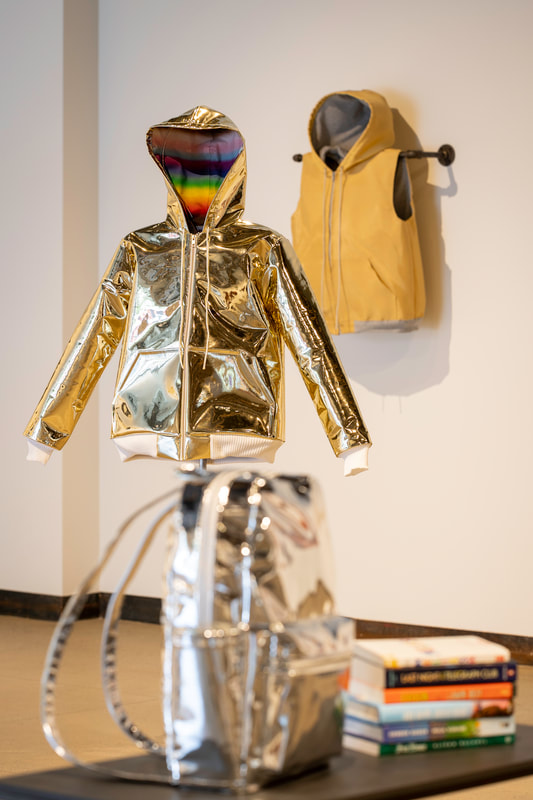
Installation view of Self (2023)
A Kind of Truth Virus
In both my perception of the world and my art, I sometimes use a ‘cut-up technique’ as a way to refresh my perception before it gets too infected with one linear idea. A concept originally introduced by the poet Tristan Tzara, ‘cut up’ is defined as “the deconstruction of a primary text using the random cutting up of words and phrases to form new sentences and thus a new piece of writing. It is a process of extraction and reconstruction of a new meaning of language, based on chaotic intuition and the free creative flow.”
The late British musician, writer, performance artist, and gender nonconformist, Genesis P. Orridge incorporated this concept in their creative pursuits (and way of life), defining it as a technique of locating control and the systems that maintain a grasp on that control, and cutting it up to pieces. In Nonbinary: A memoir, they wrote, “once you decide to devote yourself to this cut-up technique, it joyfully contaminates every aspect of your life. A kind of truth virus. And, for me, it remains the only reliable filter through which to observe this earth and the overriding culture with any hope of accuracy”.
Although Erika and matt’s techniques seem more intentional than the deliberate use of cut-up methods described above, I bring this concept up because it encompasses my personal meaning-making of the exhibition, as both their works reposition tradition and conformity to more accurately expose our current realities. Considering craft-making’s long history, from indigenous practices to colonialism to industrial expansion, contemporary craft-making has the power to ‘cut up’ the linear ideas that developed from those histories and reimagine them into new art. Art that unfastens us from the rigid definitions that don’t apply to our truth.
Kelly Sheridan is a Pittsburgh-based museum professional and artist (who’s previously shown work under the name Kelly Sherii).
